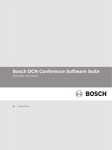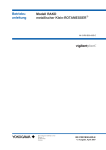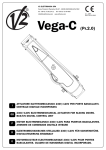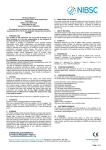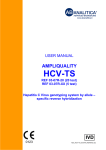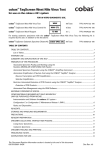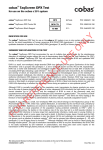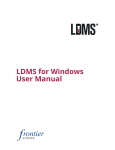Download HCV RNA Working Reagent for Nucleic Acid Amplification
Transcript
CE Marked Material HCV RNA Working Reagent for Nucleic Acid Amplification Techniques NIBSC code: 02/264-xxx Instructions for use (Version 15.0, Dated 27/05/2015) This material is an „Annex II List A‟ IVD and complies with the requirements of the “EU in vitro diagnostic medical device directive 98/79/EC”. 1. INTENDED USE This product is CE marked for use as an IVD in Europe. In all other territories it is the sole responsibility of the Recipient to ascertain whether it can be used as an IVD. The NIBSC hapatitis C virus (HCV) RNA working reagent is intended for use in the field of in-vitro diagnostics, as a run control for routine bucleic acid amplification (NAT) techniques for the detection of HCV RNA. However it is for the user to establish suitability of purpose. 2. CAUTION This preparation is not for administration to humans. The preparation contains a dilution of human plasma known to be positive for HCV RNA. The diluent is made from human plasma tested negative for ant-HCV, Anti-HIV, and HBsAg and non-reactive for HCV RNA, HIV1/HIV-2 RNA, parvovirus B19 DNA. hepatitis B DNA and hepatitis a RNA. As with all materials of biological origin, this preparation should be regarded as potentially hazardous to health. It should be used and discarded according to your own laboratory's safety procedures. Such safety procedures should include the wearing of protective gloves and avoiding the generation of aerosols. Care should be exercised in opening ampoules or vials, to avoid cuts. 3. UNITAGE The HCV working reagent code 02/264-xxx has been found to be within the specified acceptable range (2.94 - 3.25 log10 IU/ml) and has been assigned a value of 3.16 log10 IU/ml (1438 IU/ml) The unitage was derived by testing in nine independent assays using the Roche Cobas Ampliprep and Taqman 48 assay systems. Users should be aware that different batches of the same assay kit, and/or different assay conditions, may give different values with this reagent. 4. CONTENTS Country of origin of biological material: United Kingdom. The reagent consists of a batch of vials coded 02/264-xxx containing a dilution of an HCV RNA positive donation. The reagent contains a genotype 3 isolate diluted in HCV RNA negative plasma. Each vial of the reagent contains 0.5 ml of liquid. Users are encouraged to inform NIBSC of the performance of the preparation from reviews of their data monitoring. Any user who has data supporting any deteriation in the characteristics of any reference preparation is encouraged to contact NIBSC. 5. STORAGE The HCV RNA working reagent should be stored at or below -60ºC until use and each vial should preferably be used only once and then discarded. 6. DIRECTIONS FOR OPENING Vials have a screw cap; an internal stopper may also be present. The cap should be removed by turning anti-clockwise. Care should be taken to prevent loss of the contents. Please note: If a stopper is present on removal of the cap, the stopper should remain in the vial or be removed with the cap. 7. USE OF MATERIAL THE MATERIAL IS SUPPLIED FOR USE IN ITS FINAL FORM AND MUST NOT BE FURTHER DILUTED. This material is not for use in the calibration of secondary reference materials. The 3rd WHO International Standard for HCV RNA (NIBSC Code Number 06/100) is available for calibration of in-house or working standards. 8. STABILITY Reference materials are held at NIBSC within assured, temperaturecontrolled storage facilities. Reference Materials should be stored on receipt as indicated on the label. The stability of previous batches of working reagent has been monitored. These materials have not lost potency when stored at or below -60oC over a period of 8 years. The shelf life assigned to the working standard will be 5 years and indicated on the outer packaging. 9. REFERENCES None 10. ACKNOWLEDGEMENTS None 11. FURTHER INFORMATION Further information can be obtained as follows; This material: [email protected] WHO Biological Standards: http://www.who.int/biologicals/en/ JCTLM Higher order reference materials: http://www.bipm.org/en/committees/jc/jctlm/ Derivation of International Units: http://www.nibsc.org/products/biological_reference_materials/frequently_ asked_questions/how_are_international_units.aspx Ordering standards from NIBSC: http://www.nibsc.org/products/ordering_information/frequently_asked_qu estions.aspx NIBSC Terms & Conditions: http://www.nibsc.org/terms_and_conditions.aspx 12. CUSTOMER FEEDBACK Customers are encouraged to provide feedback on the suitability or use of the material provided or other aspects of our service. Please send any comments to [email protected] 13. CITATION In all publications, including data sheets, in which this material is referenced, it is important that the preparation's title, its status, the NIBSC code number, and the name and address of NIBSC are cited and cited correctly. 14. MATERIAL SAFETY SHEET Physical and Chemical properties Physical Corrosive: No appearance: Liquid Stable: Oxidising: No Yes Hygroscopic: Irritant: No No Flammable: Handling: See caution, Section 2 No Other (specify): Contains infectious HCV and materials of human origin National Institute for Biological Standards and Control, Potters Bar, Hertfordshire, EN6 3QG WHO International Laboratory for Biological Standards, UK Official Medicines Control Laboratory T +44 (0)1707 641000 nibsc.org Page 1 of 10 Toxicological properties Effects of inhalation: Avoid - contains infectious HCV Effects of ingestion: Avoid - contains infectious HCV Effects of skin absorption: Avoid - contains infectious HCV Suggested First Aid Inhalation: Seek medical advice Ingestion: Seek medical advice Contact with eyes: Wash with copious amounts of water. Seek medical advice Contact with skin: Wash thoroughly with water. Action on Spillage and Method of Disposal Spillage of ampoule contents should be taken up with absorbent material wetted with an appropriate disinfectant. Rinse area with an appropriate disinfectant followed by water. Absorbent materials used to treat spillage should be treated as biological waste. 15. LIABILITY AND LOSS In the event that this document is translated into another language, the English language version shall prevail in the event of any inconsistencies between the documents. Unless expressly stated otherwise by NIBSC, NIBSC’s Standard Terms and Conditions for the Supply of Materials (available at http://www.nibsc.org/About_Us/Terms_and_Conditions.aspx or upon request by the Recipient) (“Conditions”) apply to the exclusion of all other terms and are hereby incorporated into this document by reference. The Recipient's attention is drawn in particular to the provisions of clause 11 of the Conditions. 16. INFORMATION FOR CUSTOMS USE ONLY Country of origin for customs purposes*: United Kingdom * Defined as the country where the goods have been produced and/or sufficiently processed to be classed as originating from the country of supply, for example a change of state such as freeze-drying. Net weight: 0.5 g Toxicity Statement: Non-toxic Veterinary certificate or other statement if applicable. Attached: No National Institute for Biological Standards and Control, Potters Bar, Hertfordshire, EN6 3QG WHO International Laboratory for Biological Standards, UK Official Medicines Control Laboratory T +44 (0)1707 641000 nibsc.org Page 2 of 10 Matériel de référence non-OMS Réactif de travail pour la détection de l'ARN du VHC par les techniques d'amplification de l'acide nucléique Code NIBSC : 02/264-XXX Mode d'emploi (Version 14.00) Ce matériel est un IVD de type « Annexe II Liste A » et il est conforme aux exigences de la « Directive 98/79/EC de l'UE relative aux dispositifs médicaux de diagnostic in vitro » Le réactif se compose d'un lot de flacons codés 02/264-01 contenant une dilution d'un don positif à l'ARN du VHC. Il contient également un isolat de génotype 3 dilué dans un plasma négatif à l'ARN du VHC. Chaque flacon cintient 0,5 ml de liquide. Les utilisateurs sont invités à informer le NIBSC de la performance de la préparation après étude du monitoring de leurs données. Les utilisateurs disposant de données indiquant une détérioration des caractéristiques d'un standard de travail sont priés de contacter le NIBSC 1. UTILISATION PRÉVUE Ce produit est marqué CE pour utilisation comme IVD en Europe. Dans tous les autres territoires, il est de la seule responsabilité du destinataire de déterminer si il peut être utilisé comme un IVD. Ce produit est marqué CE pour être utilisé comme IVD en Europe, mais n’est pas enregistré pour être utilisé comme IVD en Amérique du Nord. Le réactif de travail de l'ARN du virus de l'hépatiteC (VHC) fabriqué par le NIBSC est destiné à être utilisé dans le domaine des diagnostics in vitro comm contrôle positif pour les techniques d'amplification de l'acide nucléique (NAT) de routine pour la détection de l'ARN du VHC. Toutefois, il incombe à l’utilisateur d'établir la pertinence de cet objectif. 2. MISE EN GARDE Cette préparation ne doit pas être administrée à des êtres humains. Ce matériel est d'origine humaine. Le matériel final ou les matériels sources ont été testés et trouvés négatifs vis-à-vis de l’AgHBs, des anti-VIH et de l'ARN du VHC. Comme toutes les matières d'origine biologique, cette préparation doit être considérée comme présentant potentiellement des dangers pour la santé. Elle doit être utilisée et éliminée conformément aux procédures de sécurité de votre laboratoire. De telles procédures de sécurité comportent probablement le port de gants de protection et des mesures permettant d’éviter la formation d’aérosols. Il convient de prendre des précautions lors de l’ouverture des ampoules ou des flacons pour éviter les coupures. 3. UNITÉS Le lot d’origine de réactif de travail pour la détection du VHC, code 96/586, a été évalué dans le cadre d’une étude collaborative et une valeur de 710 UI/ml lui a été attribuée (Saldanha et al, Vox Sang 2000;78:217-224). Le lot actuel de réactif de travail pour la détection de l’ARN du VHC, code 02/264-01, a été fabriqué par un procédé identique à celui utilisé pour le lot 96/586 et les lots suivants. Ce réactif a été testé dans quatre essais indépendants avec utilisant le test Roche Cobas Ampliprep et Taqman 48. Le réactif de travail pour la détection de l’ARN du VHC, code 02/264-01, a été trouvé être dans la plage acceptable spécifiée (2.95 - 3.25 log10 IU/ml) et une valeur de 3.1 log 10 IU/ml (1260 IU/ml) lui a été attribuée. Les utilisateurs doivent être informés que des lots différents provenant de la même trousse de dosage et/ou différentes conditions de dosage peuvent donner des valeurs différentes avec ce réactif. 4. CONTENU Pays d’origine du matériel biologique : Royaume-Uni. 5. CONSERVATION Le réactif de travail pour la détection de l’ARN du VHC doit être stocké à une température inférieure à -60 °C jusqu'à son utilisation et chaque flacon doit, de préférence, n'être utilisé qu’une seule fois, puis éliminé. La préparation peut être utilisée non diluée ou diluée dans du plasma humain négatif à l’ARN du VHC ou cryosurnageant. 6. CONSIGNES D‟OUVERTURE Les flacons sont dotés d'un bouchon à vis et éventuellement, d'un bouchon étanche interne. Retirez le bouchon en le faisant tourner dans le sens inverse des aiguilles d'une montre. Veillez à ne pas renverser le contenu. Veuillez noter : si un bouchon interne est présent, il doit rester dans le flacon ou être retiré avec le bouchon à vis. 7. EMPLOI DU MATÉRIEL Ce matériel est fourni prêt à l'emploi sous sa forme finale et ne doit être dilué d'aucune autre façon que celles que nécessitent les procédures de test individuelles. Il est recommandé de décongeler le réactif à température ambiante avant utilisation. Les dilutions doivent être réalisées dans du plasma humain négatif à l'ARN du VHC. Ce matériel n’est pas destiné à être utilisé dans l'étalonnage des matériels de référence secondaires. Le 2ème étalon international de l’OMS concernant l’ARN du HCV (Code NIBSC 96/798) est disponible pour étalonner des standards internes ou de travail. 8. STABILITÉ Les matériels de référence sont conservés au NIBSC dans des installations de stockage assurées, à température contrôlée. Les matériels de référence doivent être conservés dès réception comme cela est indiqué sur l'étiquette. La stabilité des lots précédents du réactif de travail a été contrôlée. Elle n’a pas diminué au cours d'une période de conservation de 8 ans à 60 °C ou moins. La durée de conservation attribuée au standard de travail sera de 5 ans et indiquée sur l'emballage extérieur. Pour obtenir des informations spécifiques sur un standard de travail particulier, veuillez contacter le Responsable des informations techniques ou, s'il est connu, le chercheur concerné du NIBSC. Le NIBSC suit la politique de l’OMS en ce qui concerne ses matériels de référence. 9. RÉFÉRENCES National Institute for Biological Standards and Control, Potters Bar, Hertfordshire, EN6 3QG WHO International Laboratory for Biological Standards, UK Official Medicines Control Laboratory T +44 (0)1707 641000 nibsc.org Page 3 of 10 Sans objet. 10. REMERCIEMENTS Sans objet. 11. AUTRES INFORMATIONS D’autres informations sont disponibles comme suit : Sur le matériel : [email protected] Normes biologiques de l’OMS : http://www.who.int/biologicals/en/ Dérivation des Unités Internationales : http://www.nibsc.ac.uk/products/faq.asp Commande de standards auprès du NIBSC : http://www.nibsc.ac.uk/products/faq.asp Termes et conditions du NIBSC : http://www.nibsc.ac.uk/terms.html Mesure en cas d'écoulement accidentel et méthode d'élimination Les écoulements accidentels provenant des flacons doit être traité avec un tampon absorbant imbibé d'un désinfectant approprié. Laver la zone avec un désinfectant approprié, puis à l’eau. Les tampons absorbants utilisés pour traiter les écoulements accidentels doivent être considérés comme des déchets présentant des dangers biologiques. 12. COMMENTAIRES DES CLIENTS Les clients sont invités à fournir leurs commentaires sur la pertinence ou l’utilisation du matériel fourni ou d’autres aspects de notre service. Veuillez adresser vos commentaires à [email protected] 13. CITATION Dans toutes les publications, y compris les fiches de données, dans lesquelles la préparation est utilisée comme matériel de contrôle de dosage, il est important que le titre de la préparation, son état, le code NIBSC et le nom et l’adresse du NIBSC soient cités correctement. 14. FICHE DE SÉCURITÉ DU MATÉRIEL Propriétés physiques et chimiques Aspect physique : Liquide Corrosif : Non Stable : Oui Oxydant : Non Hygroscopique : Non Irritant : Non Inflammable : Non Manipulation : Voir précautions, Section 2 Autre (préciser) : Contient des matières d'origine humaine et des VHC infectieux Propriétés toxicologiques 15. RESPONSABILITÉ ET PERTE Dans le cas où ce document est traduit dans une autre langue, la version anglaise prévaudra en cas de contradiction entre les documents. Sauf indication contraire par l’Institut NIBSC, les Termes et Conditions standard de NIBSC pour la fourniture de matériaux (disponible à www.nibsc.org/About_Us/Terms_and_Conditions.aspx ou à la demande du destinataire) ("Conditions") s'appliquent à l'exclusion de toutes autres conditions et sont incorporés dans le présent document par référence. L'attention du destinataire est attirée en particulier sur les dispositions de l'article 11 des Conditions 16. INFORMATIONS RÉSERVÉES À L‟USAGE DES DOUANES Pays d‟origine pour les douanes* : Royaume-Uni * Défini comme étant le pays où les produits ont été fabriqués et/ou suffisamment traités pour être classés comme provenant du pays de fourniture, par exemple un changement d'état tel que la lyophilisation. Poids net : 0,5 g Déclaration de toxicité : Non toxique Certificat vétérinaire ou autre déclaration le cas échéant Pièce jointe : Non Effets de l’inhalation : Contient des VHC infectieux, éviter l’inhalation. Effets de l’ingestion : Contient des VHC infectieux, éviter l’ingestion. Effets de l’absorption cutanée : Contient des VHC infectieux, éviter le contact avec la peau. Suggestions de mesures de première urgence: Inhalation : Consulter un médecin Ingestion : Consulter un médecin Contact avec les yeux : Laver à grande eau. Consulter un médecin Contact avec la peau : Laver minutieusement à l’eau. National Institute for Biological Standards and Control, Potters Bar, Hertfordshire, EN6 3QG WHO International Laboratory for Biological Standards, UK Official Medicines Control Laboratory T +44 (0)1707 641000 nibsc.org Page 4 of 10 Reactivo de trabajo de ARN del VHC para técnicas de amplificación de ácidos nucleicos Código NIBSC: 02/264-xxx Indicaciones de uso (Versión 14.0, fechada 13/01/2014) Este producto cuenta con el marcado CE para ser utilizado como un producto sanitario para diagnóstico in vitro (IVD) en Europa, pero su uso como un IVD no está registrado en Estados Unidos. Este material es un dispositivo para diagnóstico in vitro de la “Lista A del Anexo II” y cumple con los requisitos de la Directiva 98/79/CE de la UE sobre productos sanitarios para diagnóstico in vitro. preparado a partir de estudios de su seguimiento de los datos. Se insta a los usuarios que tengan datos que señalan un deterioro cualquiera de las características de un preparado de referencia, a tomar contacto con el NISBC. 1. 6. USO INDICADO Este producto lleva la marca CE para su uso como IVD en Europa. En todos los demás territorios, es la responsabilidad exclusiva del Destinatario el determinar si se puede utilizar como un IVD. El reactivo de trabajo de ARN del virus de la hepatitis C (VHC), fabricado por el NIBSC, está indicado para el uso diagnóstico en técnicas in vitro, como control de lote en técnicas de rutina de amplificación de ácidos nucleicos (AAN) para la detección del ARN de VHC. Sin embargo, corresponde al usuario determinar la adecuación para el fin buscado. 2. ADVERTENCIA Este preparado no debe administrarse a seres humanos. Este preparado contiene material de origen humano y el producto final o las materias primas de las cuales se obtiene han sido ensayados, dando negativo a HBsAg, antígeno de VIH y ARN de VHC. Al igual que para cualquier material de origen biológico, este preparado debe considerarse potencialmente nocivo para la salud. Se debe utilizar y desechar conforme a los procedimientos de seguridad vigentes en su laboratorio. Dichos procedimientos de seguridad deberán incluir el uso de guantes de protección así como evitar la generación de aerosoles. Cuide de no sufrir cortes al abrir ampollas o viales. 3. INFORMACIÓN CUANTITATIVA El lote original de reactivo de trabajo para VHC, código 96/586, fue evaluado en un estudio efectuado en colaboración asignándosele un valor de 710 UI/ml (Saldanha et al, Vox Sang 2000;78:217-224). El lote actual de reactivo de trabajo de ARN de VHC, con código 02/26401, fue fabricado por un proceso idéntico al de la producción de 96/586 y lotes subsiguientes. Este reactivo ha sido ensayado en cuatro análisis independientes, utilizando el análisis Roche Cobas Ampliprep/Taqman 48. Se ha determinado que el reactivo de trabajo de ARN de VHC, código 02/264-01, está dentro de los valores aceptables (2.95 - 3.25 log10 IU/ml) y se le asignó un valor de 3.1 log 10 IU/ml (1260 IU/ml). Los usuańos deben tener presente que diferentes lotes del mismo kit de análisis, asi oomo condiciones de análisis distintas, pueden arrojar valores distintos con este mismo reactive. 5. ALMACENAMIENTO El reactivo de trabajo de ARN de VHC se debe almacenar a una temperatura igual o inferior a -60 ºC hasta ser usado y es preferible que cada vial sea usado una única vez y luego desechado. El preparado se puede utilizar sin diluir o diluido en plasma humano negativo al ARN de VHC o en criosobrenadante. INSTRUCCIONES PARA LA APERTURA Los viales cuentan con una tapa roscada; es posible que lleven también un tapón interior. Se debe quitar la tapa girándola en sentido antihorario. Tenga cuidado de no perder el contenido. Nota: Si al quitar la tapa se halla un tapón, el mismo debe quedar en el vial o ser quitado junto con la tapa. 7. USO DEL MATERIAL Este material puede ser utilizado tal como se suministra o ser diluido según los requisitos de los procedimientos de análisis individuales. Se recomienda que el reactivo sea descongelado a temperatura ambiente antes de su utilización. Se debe diluir en plasma humano negativo al ARN de VHC. Este material no debe ser utilizado para calibrar materiales de referencia secundarios. El 2º Patrón Internacional OMS para ARN de VHC (código 96/798 de NIBSC) está disponible para la calibración de patrones internos o de trabajo. 8. ESTABILIDAD Los materiales de referencia se conservan en el NIBSC en instalaciones seguras a temperatura controlada. Los materiales de referencia se deben almacenar a su recepción en las condiciones indicadas en el rótulo. Se ha controlado la estabilidad de lotes anteriores del reactivo de trabajo. Estos materiales no han perdido potencia almacenados a -60 ºC o menos durante 8 años. La vida útil asignada al patrón de trabajo será de 5 años y se indicará en la envoltura exterior. Para más información acerca de un determinado patrón de trabajo, consulte al funcionario de información técnica (Technical Information Officer) o, cuando sea conocido, al correspondiente científico del NIBSC. El NIBSC sigue las directivas de la OMS en lo que hace a sus materiales de referencia. 9. REFERENCIAS Ninguna. 10. RECONOCIMIENTOS Ninguno. 4. CONTENIDO País de origen del material biológico: Reino Unido. El reactivo consiste en un lote de viales con código 02/264-01 que contienen una donación diluida de ARN positivo al VHC. El reactivo contiene una cepa vírica de genotipo 3, diluida en plasma con ARN negativo a VHC. Cada vial del reactivo contiene 0,5 ml de líquido. Instamos a los usuarios a informar al NIBSC sobre el desempeño del 11. INFORMACIÓN ADICIONAL Se puede obtener más información según se detalla a continuación. Este material: [email protected] National Institute for Biological Standards and Control, Potters Bar, Hertfordshire, EN6 3QG WHO International Laboratory for Biological Standards, UK Official Medicines Control Laboratory T +44 (0)1707 641000 nibsc.org Page 5 of 10 Normas y patrones biológicos de la OMS: http://www.who.int/biologicals/en/ A menos que se indique expresamente lo contrario por NIBSC, los Términos y Condiciones Estándar de NIBSC para el Suministro de Materiales (disponible en www.nibsc.org/About_Us/Terms_and_Conditions.aspx o previa solicitud por parte del Receptor) ("Condiciones") se aplican a la exclusión de todos los demás términos y estan incorporados en este documento como referencia. El Destinatario debe prestar atención, en particular, a las disposiciones de la cláusula 11 de las Condiciones. Materiales de referencia de orden superior del JCTLM: http://www.bipm.org/jctlm Obtención de las unidades internacionales: http://www.nibsc.ac.uk/products/faq.asp (en inglés) Encargar patrones de NIBSC: http://www.nibsc.ac.uk/products/faq.asp (en inglés) Términos y condiciones del NIBSC: http://www.nibsc.ac.uk/terms.html (en inglés) 12. COMENTARIOS DE CLIENTES Instamos a nuestros clientes a enviarnos sus comentarios sobre la adecuación o el uso de los materiales que suministramos o sobre otros aspectos de nuestro servicio. Sírvase enviar cualquier comentario a [email protected] 13. ATRIBUCIONES En todas las publicaciones, incluidas las hojas de datos, en las cuales se haga referencia a este material, es importante que se atribuyan en forma correcta: el título del preparado, su estado, el número de código del NIBSC, y el nombre y dirección del NIBSC. 14. HOJA DE DATOS SOBRE SEGURIDAD DEL MATERIAL Propiedades físicas y químicas Corrosivo: No Oxidante: No Irritante: No Manipulación: Véase la advertencia en la Sección 2. specificar): Contiene VHC contagioso y materiales de origen humano. n los ojos: n la piel: Aspecto físico: Estable: Higroscópico: Inflamable: Líquido Sí No No Propiedades toxicológicas Efectos de la inhalación: Evitar, infeccioso. Efectos de la ingestión: Evitar, infeccioso. Efectos de la absorción por la piel: Evitar, infeccioso. contiene VHC contiene VHC contiene VHC Medidas de primeros auxilios sugeridas Acuda al médico. Acuda al médico. Lavar con agua en abundancia. Acuda al médico. Lavar meticulosamente con agua. Medidas ante un derrame y método de desecho Si se derrama el contenido de una ampolla, deberá recogerse con un material absorbente mojado con un desinfectante adecuado. Lave la zona con un desinfectante adecuado y luego con agua. Los materiales absorbentes usados para resolver el derrame deberán tratarse como un desecho biológico. 15. RESPONSABILIDAD Y PÉRDIDAS En el caso de que este documento sea traducido a otro idioma, la versión en inglés prevalecerá en el caso de cualquier inconsistencia entre los documentos. National Institute for Biological Standards and Control, Potters Bar, Hertfordshire, EN6 3QG WHO International Laboratory for Biological Standards, UK Official Medicines Control Laboratory T +44 (0)1707 641000 nibsc.org Page 6 of 10 Nicht-WHO-Referenzmaterial HCV-RNS-Arbeitsreagens für Nukleinsäureamplifikationstechniken NIBSC-Code: 02/264-XXX Gebrauchsanweisung (Version 14.00) Dieses Produkt ist für die Verwendung als IVD in Europa CEgekennzeichnet, jedoch nicht für die Verwendung als IVD in Nordamerika registriert. Dieses Material ist ein IVD nach „Anhang II, Liste A“ und entspricht den Anforderungen der Richtlinie 98/79/EG der EU über In-vitro-Diagnostika. 1. VERWENDUNGSZWECK Dieses Produkt ist CE markiert für die Verwendung als IVD in Europa. In allen anderen Gebieten ist es die alleinige Verantwortung des Empfängers festzustellen ob das Produkt als IVD verwendet werden kann. Das NIBSC-Hepatitis C-Virus (HCV)-RNS-Arbeitsreagens ist zur Verwendung im Bereich der In-vitro-Diagnostik als Laufkontrolle für routinemäßige Nukleinsäureamplifikations-Techniken (NAT) zum Nachweis von HCV-RNS bestimmt. Es obliegt jedoch dem Benutzer, die Eignung für einen bestimmten Zweck festzustellen. 2. VORSICHT Dieses Präparat ist nicht zur Verabreichung an Menschen bestimmt. Das Material ist menschlichen Ursprungs, und entweder das Endprodukt oder die Ausgangsmaterialien sind auf HBsAg, Anti-HIV und HCV-RNS getestet und als negativ befunden worden. Wie alle Materialien biologischen Ursprungs muss dieses Präparat als potenziell gesundheitsgefährdend betrachtet werden. Es sollte gemäß den Sicherheitsverfahren Ihres Labors verwendet und entsorgt werden. Derartige Sicherheitsverfahren umfassen vermutlich das Tragen von Schutzhandschuhen und das Vermeiden der Entstehung von Aerosolen. Beim Öffnen von Ampullen oder Fläschchen muss vorsichtig vorgegangen werden, um Schnittverletzungen zu vermeiden. 3. EINHEITENZUWEISUNG Die Originalcharge des HCV-Arbeitsreagens Code 96/586 wurde in einer kollaborativen Studie bewertet und erhielt einen Wert von 710 IE/ml (Saldanha et al, Vox Sang 2000;78:217-224). Diese aktuelle Charge des HCV-RNS-Arbeitsreagens Code 02/264-01 ist mit Hilfe eines Verfahrens hergestellt worden, das dem der Produktion der Charge mit Code 96/586 und den nachfolgenden Chargen identisch ist. Dieses Reagenz ist in vier unabhängigen Assays unter Verwendung des Roche Cobas Ampliprep/Taqman 48 geprüft worden. Es wurde festgestellt, dass sich das HCV-RNS-Arbeitsreagenz Code 02/264-01 innerhalb des festgelegten zulässigen Bereichs (2.95 - 3.25 log10 IU/ml) befindet. Dem Reagens wurde ein Wert von 3.1 log 10 IU/ml (1260 IU/ml) zugewiesen. Es ist zu beachten, dass sich bei der Verwendung verschiedener Chargen desselben Assay-Kits und/oder unter unterschiedlichen Assay-Bedingungen mit diesem Reagens unterschiedliche Werte ergeben können. 4. INHALT Ursprungsland des biologischen Materials: Vereinigtes Königreich. Das Reagens besteht aus einer Charge von Fläschchen mit dem Code 02/764-01, die eine Verdünnung aus einer HCV-RNS-positiven Spende enthalten. Das Reagens enthält ein Genotyp 3-Isolat verdünnt in HCV-RNA-negativem Plasma. Jedes Fläschchen des Reagens enthält 0,5 ml Flüssigkeit. Benutzer werden freundlich gebeten, das NIBSC anhand der Revision ihrer Datenüberwachung über die Wirksamkeit des Präparats zu informieren. Jeder Benutzer, der Daten vorzuweisen hat, die auf eine Verschlechterung der Eigenschaften eines beliebigen Referenzpräparats deuten, wird aufgefordert, sich an das NIBSC zu wenden. 5 LAGERUNG Das HCV-RNS-Arbeitsreagens sollte bis zur Verwendung bei oder unterhalb von –60°C aufbewahrt werden, und jedes Fläschchen sollte möglichst nur einmal benutzt und anschließend entsorgt werden. Das Präparat kann unverdünnt oder in HCV-RNS-negativem menschlichen Plasma oder Kryoüberstand verdünnt verwendet werden. 6 ANWEISUNG ZUM ÖFFNEN Die Fläschchen haben einen Deckel mit Schraubverschluss. Außerdem kann ein Innenstopfen vorhanden sein. Der Schraubdeckel sollte durch Drehen gegen den Uhrzeigersinn abgenommen werden. Es muss darauf geachtet werden, dass der Inhalt nicht verschüttet wird. Bitte beachten: Ist bei Abnehmen des Schraubdeckels ein Stopfen vorhanden, muss der Stopfen entweder im Fläschchen verbleiben oder mit dem Deckel entfernt werden. 7. VERWENDUNG DES MATERIALS Dieses Material wird entweder zur Verwendung in seiner endgültigen Form oder gemäß individueller Testverfahren verdünnt geliefert. Es wird empfohlen, das Reagens vor der Verwendung bei Raumtemperatur aufzutauen. Verdünnungen müssen in HCV-RNSnegativem menschlichen Plasma erfolgen. Dieses Material ist nicht zur Verwendung bei der Kalibrierung von sekundärem Referenzmaterial bestimmt. Zur Kalibrierung von internen oder Arbeitsstandards ist der 2. Internationale WHO-Standard für HCV-RNS (NIBSC-Codenummer 96/798) erhältlich. 8. STABILITÄT Referenzmaterialien werden beim NIBSC in gesicherten, temperaturgeregelten Lagerräumen aufbewahrt. Referenzmaterialien müssen nach Erhalt nach Anweisung auf dem Etikett aufbewahrt werden. Die Stabilität früherer Chargen des Arbeitsreagens ist überwacht worden. Diese Materialien haben bei Aufbewahrung bei oder unterhalb von –60°C über einen Zeitraum von 8 Jahren nicht an Wirksamkeit verloren. Die Haltbarkeit des Arbeitsstandards beträgt 5 Jahre und ist auf der Umverpackung angegeben. Informationen über einen bestimmten Arbeitsstandard erhalten Sie beim technischen Informationsbeauftragen oder, soweit bekannt, beim zuständigen NIBSC-Wissenschaftler. NISBC befolgt bezüglich seiner Referenzmaterialien die Richtlinien der WHO. 9. LITERATUR Keine 10. DANKSAGUNGEN Keine 11. WEITERE INFORMATIONEN Weitere Informationen sind erhältlich bei: Zu diesem Material: [email protected] Biologische WHO-Standards: Http://www.who.int/biologicals/en/ Herleitung internationaler Einheiten: Http://www.nibsc.ac.uk/products/faq.asp Bestellung von Standards beim NIBSC. Http://www.nibsc.ac.uk/products/faq.asp Geschäftsbedingungen des NIBSC: Http://www.nibsc.ac.uk/terms.html 12. KUNDENRÜCKMELDUNGEN Die Kunden werden ermutigt, Rückmeldungen über die Eignung oder Verwendung des gelieferten Materials oder andere Aspekte unserer Dienstleistungen einzusenden. Bitte schicken Sie alle Kommentare an [email protected] 13. ZITIERUNG IN DER LITERATUR Bei allen Veröffentlichungen, einschließlich Datenblättern, in denen auf dieses Material verwiesen wird, ist es wichtig, dass die Bezeichnung, der Status und die NIBSC-Codenummer des Präparats sowie Name und Anschrift des NIBSC zitiert, und zwar korrekt zitiert werden. National Institute for Biological Standards and Control, Potters Bar, Hertfordshire, EN6 3QG WHO International Laboratory for Biological Standards, UK Official Medicines Control Laboratory T +44 (0)1707 641000 nibsc.org Page 7 of 10 14. MATERIALSICHERHEITSDATENBLATT Physikalische und chemische Eigenschaften Zustand: Flüssig Korrodierend: Nein Stabil: Oxidierend: Nein Ja Hygroskopisch: Reizend: Nein Nein Entflammbar: Handhabung: Siehe Warnhinweis, Nein Abschnitt 2 Sonstige (bitte angeben): Enthält infektiöse HCV und Materialien menschlichen Ursprungs origin Toxikologische Eigenschaften Wirkung bei Einatmen: Ursprungsland für Zollzwecke*: Vereinigtes Königreich *Als das Land definiert, in dem die Waren produziert und/oder ausreichend verarbeitet worden sind, um als aus dem Lieferland stammend klassifiziert zu werden, zum Beispiel durch eine Zustandsänderung wie Gefriertrocknen. Nettogewicht:0,5 g Toxizitätserklärung: Nicht toxisch Tiermedizinische Bescheinigung oder andere Erklärung: ggfs. Beigefügt: Nein Beigefügt: Nein Vermeiden – enthält infektiöse HCV Wirkung bei Verschlucken: Vermeiden – enthält infektiöse HCV Wirkung bei Absorption durch die Haut: Vermeiden – enthält infektiöse HCV Empfohlene Erste Hilfe-Maßnahmen: Einatmen: Ärztliche Hilfe suchen. Verschlucken: Ärztliche Hilfe suchen. Augenkontakt: Mit reichlich Wasser spülen. Ärztliche Hilfe suchen. Hautkontakt: Gründlich mit Wasser abwaschen. Maßnahmen bei Verschütten und Entsorgungsmethoden Verschütteter Ampulleninhalt muss mit absorbierendem Material aufgenommen werden, das mit einem geeigneten Desinfektionsmittel benetzt worden ist. Spülen Sie den Bereich mit einem geeigneten Desinfektionsmittel und anschließend mit Wasser. Absorbierendes Material, das zum Aufnehmen von verschüttetem Inhalt verwendet worden ist, muss als biologischer Abfall entsorgt werden. 15. HAFTUNGSAUSSCHLUSS Für den Fall, dass dieses Dokument in eine andere Sprache übersetzt wird, gilt die englische Version falls Unstimmigkeiten zwischen den Dokumenten auftreten. Sofern nicht ausdrücklich anders von NIBSC angegeben, gelten die NIBSC allgemeinen Geschäftsbedingungen für die Lieferung von Materialien www.nibsc.org/About_Us/Terms_and_Conditions.aspx oder auf Anforderung des Empfängers) ("Bedingungen") zum Ausschluss aller anderen Bestimmungen und werden hiermit unter Bezug in dieses Dokument eingearbeitet. Die Aufmerksamkeit des Empfängers wird insbesondere auf die Bestimmungen der Klausel 11 der Bedingungen gezogen 16. INFORMATIONEN FÜR DEN ZOLL National Institute for Biological Standards and Control, Potters Bar, Hertfordshire, EN6 3QG WHO International Laboratory for Biological Standards, UK Official Medicines Control Laboratory T +44 (0)1707 641000 nibsc.org Page 8 of 10 Materiale di riferimento non OMS Reagente di lavoro HCV-RNA per tecniche di amplificazione degli acidi nucleici Codice NIBSC: 02/264-XXX Istruzioni per l‟uso (Versione 14.00) 5. CONSERVAZIONE Prima dell’uso il reagente di lavoro HCV-RNA va conservato a una temperatura non superiore a –60 ºC e ciascun flaconcino va usato preferibilmente una sola volta e poi smaltito. La preparazione può essere usata diluita in plasma umano HCV-RNA-negativo o in criosurnatante, oppure non diluita 6. ISTRUZIONI PER L‟APERTURA I flaconcini presentano un cappuccio a vite; può essere presente anche un tappo interno. Il cappuccio va rimosso, ruotandolo in senso antiorario. Maneggiare con cautela, per evitare la perdita di contenuto. Nota: Se presente, il tappo interno deve rimanere nel flaconcino o essere rimosso assieme al cappuccio. Il presente prodotto è marcato CE per l‟uso nella diagnostica in vitro in Europa, ma non è registrato per l‟uso nella diagnostica in vitro nell‟America del Nord. Questo è un prodotto IVD (per uso diagnostico in vitro) „Allegato II Lista A‟ ed è conforme ai requisiti della “Direttiva europea sui dispositivi medicodiagnostici in vitro 98/79/CE” 1. USO PREVISTO Questo prodotto è contrassegnato CE per l'uso come IVD in Europa. In tutti gli altri territori esclusiva responsabilità del destinatario verificare se possa essere utilizzato come IVD. Il reagente di lavoro RNA del virus dell’epatite C (HCV) NIBSC è destinato all’uso nel campo della diagnostica in vitro, come controllo di esecuzione delle tecniche di amplificazione degli acidi nucleici (NAT) di routine per il rilevamento dell’HCV-RNA. Tuttavia, spetta all’utente stabilirne l’idoneità allo scopo. 8 2. ATTENZIONE Questa preparazione non è destinata alla somministrazione nell’uomo. Il materiale è di origine umana e il prodotto finale o i materiali di partenza sono stati sottoposti a test e sono risultati negativi per HBsAg, per gli anticorpi anti-HIV e per HCV-RNA. Come tutti i materiali di origine biologica, questa preparazione deve essere considerata potenzialmente pericolosa per la salute e va usata e smaltita in conformità alle misure di sicurezza del laboratorio. Tali misure di sicurezza richiederanno probabilmente di indossare guanti protettivi e di evitare la formazione di aerosol. L’apertura delle fiale o dei flaconcini va effettuata con cautela, per evitare di ferirsi. 3. 4. QUANTITÀ UNITARIA Il lotto originale del reagente di lavoro HCV codice 96/586 è stato valutato in uno studio collaborativo e gli è stato attribuito un valore di 710 UI/ml (Saldanha et al, Vox Sang 2000;78:217-224). Questo lotto attuale del reagente di lavoro HCV-RNA codice 02/264-01 è stato prodotto mediante un processo identico a quello del 96/586 e dei lotti successivi. Questo reagente è stato esaminato in quattro test indipendenti usando il test Roche Cobas Ampliprep/Taqman 48. Il reagente di lavoro HCV-RNA codice 02/264-01 è risultato compreso nell’intervallo accettabile specificato (2.95 - 3.25 log10 IU/ml) e gli è stato attribuito un valore di 3.1 log 10 IU/ml (1260 IU/ml). Gli utenti devono essere consapevoli che differenti lotti dello stesso kit per il saggio, e/o diverse condizioni di saggio, potrebbero dare valori differenti con questo reagente. CONTENUTO 12. Paese di origine del materiale biologico: Regno Unito. Il reagente è costituito da un lotto di flaconcini, con codice 02/264-01, contenenti una diluizione di una donazione HCV-RNA-positiva. Il reagente contiene un isolato del genotipo 3, diluito in plasma HCVRNA-negativo. Ciascun flaconcino di reagente contiene 0,5 mg di 13. liquido. Gli utenti sono invitati a informare il NIBSC sulle prestazioni della preparazione in base alla verifica del monitoraggio dei dati in loro possesso. Gli utenti in possesso di dati a sostegno di un eventuale deterioramento delle caratteristiche di qualsiasi preparazione di riferimento sono invitati a rivolgersi al NIBSC. 7. USO DEL MATERIALE Questo materiale è destinato all’uso nella sua forma finale o diluito, a seconda di quanto richiesto dalle procedure di ogni singolo test Prima dell’uso, si consiglia di scongelare il reagente a temperatura ambiente. Le diluizioni vanno effettuate in plasma umano HCV-RNAnegativo. Questo materiale non è destinato all’uso nella calibrazione di materiali di riferimento secondari. Per la calibrazione di standard interni o di lavoro, è disponibile il 2° Standard internazionale OMS per l’HCV-RNA (numero di codice NIBSC 96/798). STABILITÀ I materiali di riferimento sono conservati presso il NIBSC, all’interno di impianti per la conservazione garantiti a temperatura controllata. I materiali di riferimento vanno conservati alla ricezione come indicato sull’etichetta. È stata monitorata la stabilità dei lotti precedenti del reagente di lavoro. Questi materiali non hanno perso efficacia se conservati a una temperatura non superiore a -60 °C per un periodo di 8 anni. Il periodo di validità attribuito allo standard di lavoro sarà di 5 anni e dovrà essere indicato sulla confezione esterna. Per le informazioni riguardanti uno specifico standard di lavoro, rivolgersi al funzionario addetto alle informazioni tecniche oppure, se se ne conosce il nome, allo specialista NIBSC del caso. Il NIBSC segue la linea di condotta dell’OMS per quanto riguarda i suoi materiali di riferimento. 9.RIFERIMENTI BIBLIOGRAFICI Non disponibili 10.RINGRAZIAMENTI Non disponibili 11.ALTRE INFORMAZIONI Per ulteriori informazioni: Questo materiale: [email protected] Standard biologici OMS: Http://www.who.int/biologicals/en/ Derivazione delle Unità Internazionali: Http://www. nibsc.ac.u k/products/faq.asp Ordinazione di standard presso il NIBSC: Http://www. nibsc.ac.u k/products/faq.asp Termini e condizioni del NIBSC: Http://www.nibsc.ac.uk/terms.html RISPOSTA DEL CLIENTE I clienti sono invitati a inviare commenti sull’adeguatezza o sull’uso del materiale fornito o su altri aspetti del nostro servizio. Si prega di inviare i commenti a [email protected] CITAZIONE È importante citare correttamente il titolo della preparazione, lo stato, il numero di codice NIBSC, il nome e l’indirizzo del NIBSC in tutte le pubblicazioni, incluse le schede dei dati, in cui si fa riferimento a questo materiale. National Institute for Biological Standards and Control, Potters Bar, Hertfordshire, EN6 3QG WHO International Laboratory for Biological Standards, UK Official Medicines Control Laboratory T +44 (0)1707 641000 nibsc.org Page 9 of 10 Paese di origine ai fini doganali *: Regno Unito * Il Paese in cui le merci sono state prodotte e/o processate sufficientemente da essere classificate come originanti dal Paese di fornitura, ad esempio un cambio di stato fisico, quale la liofilizzazione. Peso netto: 0,5 g Dichiarazione sulla tossicità: Non tossico Certificato veterinario o altra dichiarazione, se necessaria. Allegato: No 14. SCHEDA DI SICUREZZA DEL MATERIALE Proprietà fisiche e chimiche Aspetto fisico: Liquido Corrosivo: No Stabile: Ossidante: No Sì Igroscopico: Irritante: No No Infiammabile: Manipolazione: Vedere ATTENZIONE, No sezione 2 Altro (specificare): Contiene HCV infettante e materiali di origine umana Proprietà tossicologiche Effetti dell’inalazione: Evitare l’inalazione, contiene HCV infettante Effetti dell’ingestione: Evitare l’ingestione, contiene HCV infettante Effetti dell’assorbimento cutaneo: Evitare il contatto con la cute – contiene HCV infettante Suggerimenti per il primo soccorso Inalazione: Rivolgersi a un medico Ingestione: Rivolgersi a un medico Contatto con gli occhi: Lavare con abbondante Rivolgersi a un medico Contatto con la cute: Lavare accuratamente con acqua. acqua. Provvedimenti in caso di fuoriuscita e metodo di smaltimento Raccogliere il liquido fuoriuscito dalle fiale con un panno assorbente imbevuto di un disinfettante adeguato. Detergere la superficie con un disinfettante adeguato e risciacquare con acqua. Il materiale assorbente usato per raccogliere le fuoriuscite va considerato come rifiuto a rischio biologico. 15 RESPONSABILITÀ E DANNI Nel caso in cui questo documento viene tradotto in un'altra lingua, la versione in lingua inglese prevarrà in caso di eventuali incongruenze tra i documenti. Salvo esplicita indicazione contraria da parte di NIBSC, le Condizioni Generali di NIBSC per la fornitura di materiali (disponibile a www.nibsc.org/About_Us/Terms_and_Conditions.aspx o su richiesta da parte del destinatario) ("Condizioni") si applicano con esclusione di tutti gli altri termini e sono incluse nel presente documento per riferimento. Si prega il destinatario di portare particolare attenzione alle disposizioni della clausola 11 delle Condizioni. 16. INFORMAZIONI PER SOLO USO DOGANALE National Institute for Biological Standards and Control, Potters Bar, Hertfordshire, EN6 3QG WHO International Laboratory for Biological Standards, UK Official Medicines Control Laboratory T +44 (0)1707 641000 nibsc.org Page 10 of 10











